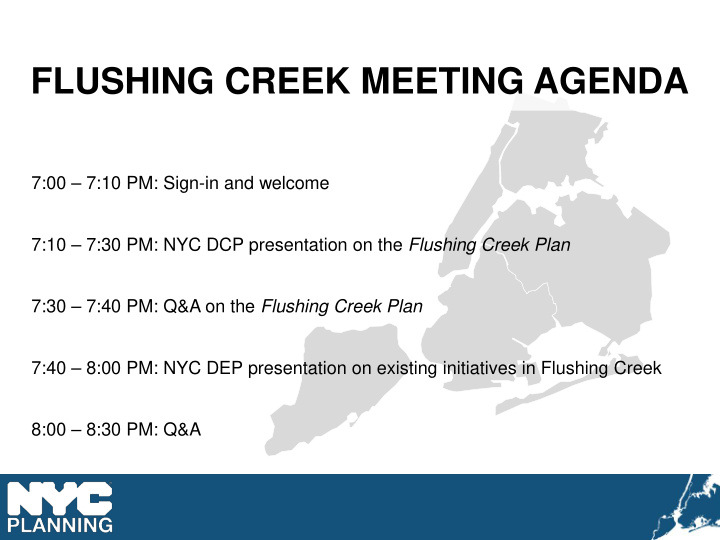



FLUSHING CREEK MEETING AGENDA 7:00 – 7:10 PM: Sign-in and welcome 7:10 – 7:30 PM: NYC DCP presentation on the Flushing Creek Plan 7:30 – 7:40 PM: Q&A on the Flushing Creek Plan 7:40 – 8:00 PM: NYC DEP presentation on existing initiatives in Flushing Creek 8:00 – 8:30 PM: Q&A
THE FLUSHING CREEK PLAN NYC Department of City Planning April 2, 2019 This planning project is being funded by the New York State Department of State under Title 11 of the Environmental Protection Fund.
Study Context • The Flushing Creek Plan is an outgrowth of a NYS Brownfield Opportunity Area (BOA) Program Nomination Study • Sponsored by the Flushing Willets Point Corona Local Development Corporation (FWCLDC) • Designated a BOA in 2018 • The BOA nomination will help facilitate redevelopment of brownfield sites • Mixed-use development with waterfront public access • Improved circulation between Downtown Flushing and Flushing Creek • The BOA study also identified a need to “support the long-term improvement of water quality in Flushing Creek”
The Flushing Creek Plan • Funded by NYS Department of State Grant • Focus on long-term barriers to improving the ecology of the creek, such as the Federal Navigation Channel • Preliminary recommendations available by August 2019 4
Historical Context 1924 1966 5
Activities in Flushing Bay and Flushing Creek • NYC DEP Environmental Dredging & Restoration (2018) • HRE Ecosystem Restoration Feasibility Study (ongoing) • Con Edison Environmental Remediation (2018) • U.S. Army Corps Dredging for Navigation (2015 & ongoing) 6
Active Industrial Use north of Northern Blvd 7
Study Area • Examining the Federal Navigation Channel south of Northern Boulevard • Army Corps will only maintain the Federal Navigation Channel at the authorized depth of 15 feet • Army Corps will only dredge when the use of the waterfront requires clear navigation channels • Federal, state, or city agencies cannot conduct ecological restoration projects in or near the channel 8
Deauthorization Process • Undertake a study on Present and Predicted Future Uses • Requires U.S. Congressional legislation • Introduce language in the next Water Resources Development Act (WRDA) • WRDA bills typically pass Congress every ~2 years 9
Deauthorization Example: Lower Passaic River, NJ • Long history of industrial use left toxic contaminants in the Lower Passaic River’s sediments • EPA superfund project to cleanup 8 miles of the river • Deauthorized portion of Federal Navigation Channel to enable environmental dredging and capping Image credit: NOAA 10
Deauthorization Example: Burnham Canal, Milwaukee, WI • Burnham Canal was a Federal Navigation Channel used for industrial purposes as early as the 1870s • Canal eventually fell into disuse and a highway was constructed, blocking navigation • City proposed wetlands restoration as part of a superfund cleanup project • Required deauthorizing the navigation channel Image Credit: U.S. Army Corps of Engineers Image Credit: U.S. Army Corps of Engineers
Next Steps Step 1 : Continue to collaborate with community stakeholders on the issue of the Federal Navigation Channel and process for deauthorization Step 2 : Undertake analysis of future projects and funding sources Step 3 : Hold public meeting to discuss preliminary findings and possible recommendations 12
Recommend
More recommend